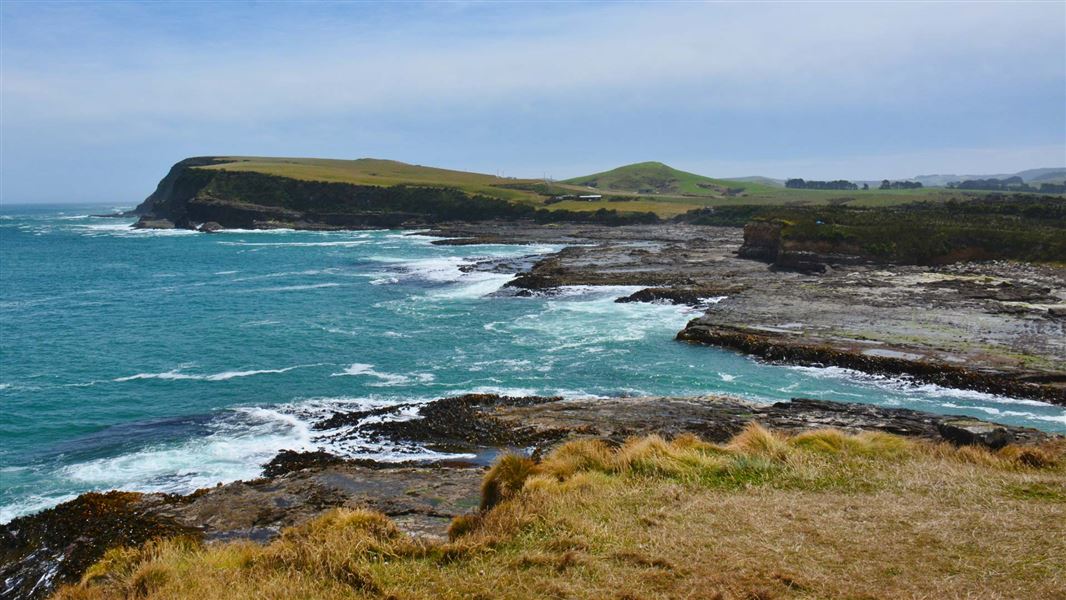Brochures
Curio Bay is signposted from the Southern Scenic Route, which follows SH 92 through the Catlins from Invercargill to Balclutha.
Visitors can either travel via Otara with the option of stopping at Waipapa Point, or the more direct route through Tokanui and Waikawa. Much of the road between Otara and Curio Bay is unsealed.
No drones
Drones are not allowed at the Fossil Forest.
Caring for wildlife
Do not feed the dolphins. When swimming or kayaking do not approach them - they will come to you if they want to. Always enter the water at least 50 m away from any dolphin. They have sensitive skin so don't touch them.
All dogs should be kept well clear of areas inhabited by penguins, seals and sea lions.
Seals and sea lions may look placid but they are powerful, wild predators and can be very dangerous if they are approached too closely - keep at least 30 m away. Do not disturb pups.
It is an offence to disturb or harass any native wildlife.
Wildlife, including Hector's dolphins, yellow-eyed penguins, fur seals and sea lions, can be found at Curio and Porpoise bays. The area also contains the fossilised remains of an ancient forest and has an interesting history.
Bird and wildlife watching
In summer Hector's dolphins/papakanua play in the surf. Yellow-eyed penguins/hoioho nest in the area around Curio Bay/Waikawa and fur seals and sea lions regularly haul themselves out of the water along the coastline.
The fossilised forest can be explored at low tide. There is a viewing platform and information panel overlooking the fossilised forest.
Yellow-eyed penguin/hoiho
Several hoiho or yellow-eyed penguins nest in the area around Curio Bay/Waikawa. They are one of the rarest penguins in the world with an estimated total population in New Zealand of between 6000 and 7000. The population has declined because of the clearance of coastal forest in which the penguins nest. They are also affected by introduced predators such as stoats, ferrets and dogs, while stock may disturb their nests.
Eggs are laid in September/October and both parents incubate and help rear chicks. Birds usually leave the nest for the sea early in the morning, returning late afternoon/early evening.
The penguins moult between February and April when they are particularly vulnerable to disturbance.
New Zealand fur seal and sea lion
New Zealand fur seals and sea lions regularly haul themselves out of the water along the Catlins coastline. Both species spend considerable time ashore with seals usually found on rocky shorelines and sea lions on sandy beaches.
The New Zealand fur seal was hunted early last century for skins until no colonies were left on the mainland. The population is now estimated to be around 50,000 - a quarter of the original population.
Other wildlife
Blue penguins nest in burrows around Porpoise Bay while Stewart Island shags can be seen on rock stacks below the headland and muttonbirds/tītī in groups off shore. White-fronted terns can also be seen around the bays.
Fossil forest
The fossilised remains of an ancient forest is exposed at Curio Bay during low tide. This is one of the most extensive and least disturbed examples of a Jurassic fossilised forest in the world and stretches about 20 kms from Curio Bay south west to Slope Point.
180 million years ago the Curio Bay area was a broad forested coastal floodplain. During this time, (known as the middle Jurassic period), New Zealand was part of the eastern margin of the ancient super-continent known as Gondwana. North of Curio Bay, most of future New Zealand was beneath the sea.
The forest predominantly consisted of trees forming a low canopy over an undergrowth dominated by ferns.
Massive sheet floods of volcanic debris, perhaps triggered by heavy rain on a barren volcanic mountain, are believed to have destroyed the forest. The forest eventually grew back only to again be flooded by volcanic debris. This happened at least four times over a period of about 20,000 years. The sequence of events is clearly recorded by distinct bands of fossilised tree stumps and wood exposed today in the cliff face.
In the millions of years, since the sediments were buried deeply and impregnated over time with silica minerals, eventually turning the wood to rock. In some places fern fronds and leaves have been preserved as fossils within the mudstone rocks.
About 100 million years ago New Zealand split away from Gondwana and slowly drifted north.
Over the last 10,000 years New Zealand’s current coast line has been formed and the sea has eroded away the layers of sandstone and clays - exposing tree stumps and logs.
This internationally important site can be explored at low tide. Souvenir hunters have removed some of these rare fossils over the years and this practice is illegal. Leave the fossilised forest undisturbed for others to enjoy.
A viewing platform and information panel has been provided overlooking the fossilised forest.
The whole of the Catlins was an important area for Māori. Forest birds, cabbage tree sugar, fish, cockles, pipis, eels and lamprey (which were caught on the first full moon in spring), were important food sources. Waikawa harbour was a seasonal campsite.
The first Europeans in the area were sealers and whalers. A short-lived whaling station was established just inside Waikawa Harbour entrance in 1838. It was abandoned by 1844.
Waikawa developed as a timber port in the 1880’s and in 1889 had a pub, a couple of stores and a blacksmiths shop. The main communication with the outside was by coastal steamer which shipped timber to Dunedin.
Today the main activities in the area are based around a small fishing fleet at Waikawa, farming and tourism.
DOC Customer Service Centre
| Phone: | 0800 275 362 |
| Email: | invercargill@doc.govt.nz |
| Address: | Murihiku / Invercargill Office |
